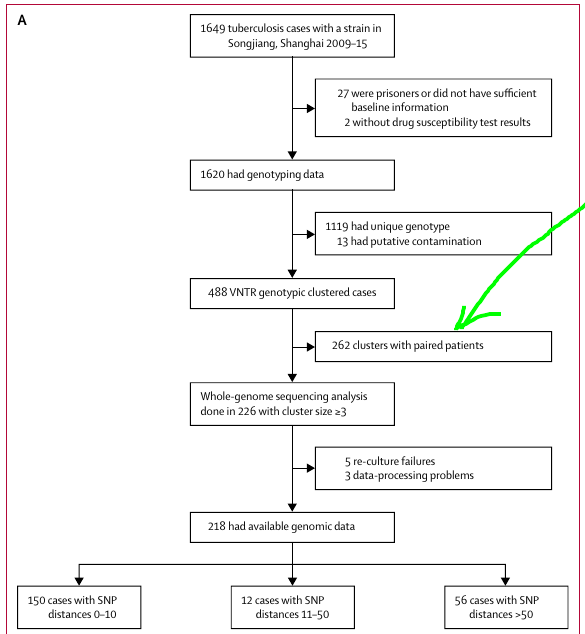Internal migration and transmission dynamics of tuberculosis
Posted on
A population-based study of culture-positive A sputum culture(痰培养)is a test to find germs (such as TB bacteria) that can cause an infection. A sample of sputum is added to a substance that promotes the growth of bacteria. If no bacteria grow, the culture is negative. If bacteria grow, the culture is positive. If TB bacteria grow, then the person has tuberculosis. source Mycobacterium tuberculosis (结核杆菌) isolates in Songjiang, Shanghai.
- use whole-genome sequencing to discriminate apparent genetic clusters of M tuberculosis sharing identical variable-number-tandem-repeat (VNTR) patterns
- analyze the relations between proximity of residence and the risk of genomically clustered M. tuberculosis
- use genomic, spatial, and epidemiological data to estimate time of infection and transmission links among migrants and residents.
Findings:
- 69% people shares identical VNTR patterns had isolates within ten single-nucleotide polymorphisms (SNPs) of at least one other strain
- pairs of strains collected from individuals living in close proximity were more likely to be genetically similar than those from individuals who lived far away
- for every additional km of distance between patients’ homes, the odds that genotypically matched strains were within ten SNPs of each other decreased by about 10%
- infer that transmission from residents to migrants occurs as commonly as transmission from migrants to residents
- estimate that more than two-thirds of migrants in genomic clusters were infected locally after migration
Interpretation: the primary mechanism driving local incidence of tuberculosis in urban centres is local transmission between both migrants and residents
Introduction
In China, the notification rate of tuberculosis According to WHO, The number of TB cases (new and relapse) notified to the national health authorities during a specified period of time per 100,000 population. is substantially higher in rural than in urban communities, and increased notifications and transmission of tuberculosis in cities have been predicted as a result.
Research in context
Evidence before the study
- search PubMed (and CNKI and WANFANG) with key terms “tuberculosis”, “China”, “migrant” and “floating population”
- found no studies of how-rural-to-urban population shifts in China contribute to tuberculosis dynamics in large cities.
Added value of this study
- increase in internal migration have been associated with increasing overall rates of tuberculosis notification in Songjiang
- migrants have significantly higher rates of tuberculosis than residents
- most clustered disease in migrants was the result of local transmission events within Songjiang
- transmission from residents to migrants occurred as commonly as transmission from migrants to residents
Implications of all the available evidence
- suggest the need for new interventions that can interrupt transmission in cities
- introduction of more active approaches for case finding
- reduction of barriers to diagnosis and treatment for both migrants and residents
Methods
Study design and participants
all people aged 15 years or older with tuberculosis symptoms
- including cough for at least 2 weeks, fever, chest pain, weight loss, night sweats, and abnormal chest radiographs
- patients in prison were excluded
Beijing family strains is the most prevalent strains in China.
Procedures
- collect sputum samples, and test it for Mycobacterium tuberculosis
- obtain demographic, clinical and microbiological records
Genotyping and whole-genome sequencing

Spatial distance analysis and transmission inference
To test the hypothesis that spatial proximity was associated with greater genetic similarity (i.e., a smaller SNP distance), the paper employed a multivariable logistic regression model where the full model includes the following independent variables:
- geographic distance between the pair of residential addresses (km),
- a combination of genetic sub lineages of the paired strains (i.e., pairwise combination of non-Beijing strains, Beijing modern and Beijing ancient strains),
- and the household status of the paired patients (i.e., migrant-migrant, resident-resident and migrant-resident). The model was evaluated and fitted by comparing the full model and the model without the covariates (genetic sub lineages and/or household status) and the model with smaller Akaike information criterion (AIC) value was preferred. In addition, we evaluated the robustness of our findings by using multiple definitions of genetic clustering for the dependent variable.
And it reports the following table,

I have no idea how the multivariate logistic regression works!
Results & Discussions
- Traditional epidemiological investigations did not identify most estimated trans-mission links, and were especially poor for identification of links between migrants and residents. The authors uncovered previously unsuspected links, and showed that genomically clustered strains infecting both migrants and residents were as likely to have been transmitted by residents to migrants as from migrants to residents.